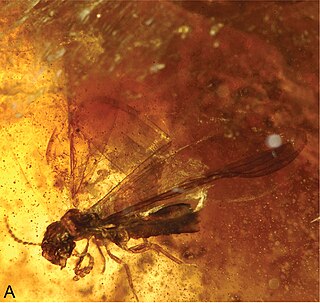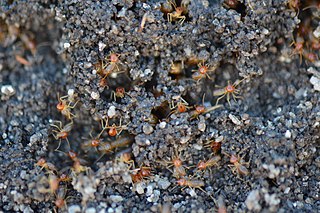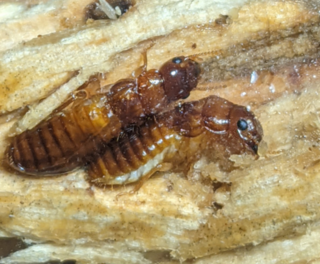
Termites are a group of detritophagous eusocial insects which consume a wide variety of decaying plant material, generally in the form of wood, leaf litter, and soil humus. They are distinguished by their moniliform antennae and the soft-bodied and typically unpigmented worker caste for which they have been commonly termed "white ants"; however, they are not ants, to which they are distantly related. About 2,972 extant species are currently described, 2,105 of which are members of the family Termitidae.
Michael S. Engel, FLS, FRES is an American paleontologist and entomologist, notable for contributions to insect evolutionary biology and classification. In connection with his studies he has undertaken field expeditions in Central Asia, Asia Minor, the Levant, Arabia, eastern Africa, the high Arctic, and South and North America, and has published more than 925 papers in scientific journals and over 1000 new living and fossil species. Some of Engel's research images were included in exhibitions on the aesthetic value of scientific imagery.

Amitermitinae is a disputed subfamily of "higher termites" now often merged with the subfamily Termitinae and is considered by ITIS as a synonym; it had previously been placed in the family Rhinotermitidae.

Termitidae is the largest family of termites consisting of 2,105 described species of which are commonly known as the higher termites. They are evolutionarily the most specialised termite group, with their highly compartmentalized hindgut lacking the flagellated protozoans common to "lower termites", which are instead replaced by bacteria. Whereas lower termites are restricted mostly to woody tissue, higher termites have diverse diets consisting of wood, grass, leaf litter, fungi, lichen, faeces, humus and soil. Around 60% of species rely on soil-feeding alone.

Kalotermitidae is a family of termites, commonly known as drywood termites. Kalotermitidae includes 21 genera and 419 species. The family has a cosmopolitan circumtropical distribution, and is found in functionally arid environments.

Coptotermes gestroi, commonly known as the Asian subterranean termite is a small species of termite that lives underground. Both this species and the Formosan subterranean termite are destructive pests native to Asia, but have spread to other parts of the world including the United States. In Asia, this species is known as the Philippine milk termite.
Serritermitidae is a family of termites belonging to the infraorder Isoptera in the order Blattodea. The family includes only a few species, which live in South America.

Amitermes meridionalis, commonly known as the magnetic termite or compass termite, is a species of eusocial insect in the family Termitidae. It is endemic to northern Australia and the common names derive from the fact that the wedge-shaped mound is aligned with its main axis running north and south.

Coptotermes lacteus, the milk termite, is a species of termite in the family Rhinotermitidae, native to Australia. These termites are social insects and build a communal nest in the form of a mound. From this, a network of galleries extends through the nearby soil, enabling the workers to forage in the surrounding area without emerging on the surface of the ground.

Amitermes hastatus, commonly known as the black mound termite, is a species of termite found in the Western Cape region of South Africa. It is endemic to the region's fynbos ecosystem. They build distinctive black termite mounds that range in height from a few centimeters to 50 centimeters. The species is commonly found on sandy soil eroded from white Table Mountain sandstone at altitudes from just under 100 meters up to 900 meters above sea level.

Gnathamitermes perplexus, the long-jawed desert termites or tube-building termites, is a species of termite in the family Termitidae. It is found in Central America and North America. The species creates tunnels, with both colony founders and workers transporting sand to excavate tunnels using their mandibles. The species is particularly susceptible to infectious nematodes such as Steinernema riobrave.

Gnathamitermes is a genus of termites in the family Termitidae. There are about six described species in Gnathamitermes.

Hospitalitermes is an Asian–Papuan genus of lichen eating termite in the subfamily Nasutitermitinae. There are 37 species currently listed, of which most are recognized for their extensive surface foraging columns. Due to their conspicuous foraging activities they are commonly known as processionary or marching termites. They often inhabit cavities inside of living trees excavated by other species of termite.
Amitermes floridensis, commonly known as the Florida darkwinged subterranean termite, is a species of eusocial insect in the family Termitidae. It feeds on rotting wood, reached by a network of tunnels. It is endemic to west central Florida and was first described in 1989.

Neotermes jouteli is a species of Neotropical termite in the family Kalotermitidae which is native to South Florida and surrounding West Indian nations. N. jouteli is the largest species of termite in Florida with soldiers reaching a maximum length of 13.35 mm and the winged alates around 16.05 mm.

Syntermes is a genus of large Neotropical higher termites within the subfamily Syntermitinae. The genus is found only in South America where members are distributed widely throughout the continent, being found from the tropical rainforests of Colombia to the savannas of Brazil and Northern Argentina.
Glyptotermes is a genus of termite in the family Kalotermitidae. With 127 species worldwide as of 2013, is the family's most speciose genus, and the second most speciose in the New World after Cryptotermes.

Constrictotermes is a genus of Neotropical higher termites within the subfamily Nasutitermitinae. They form large open-air foraging columns from which they travel to and from their sources of food, similar to the Indomalayan species of processionary termites. Species of this genus commonly build epigeal or arboreal nests and feed on a variety of lichens, rotted woods and mosses.
The Syntermitinae, also known as the mandibulate nasutes, is a Neotropical subfamily of higher termites represented by 21 genera and 103 species. The soldier caste of members of this subfamily have a conspicuous horn-like projection on the head which is adapted for chemical defense, similar to the fontanellar gun of true nasute termites. However unlike true nasutes, the mandibles of the soldiers are functional and highly developed, and they are unable to expel their chemical weaponry at a distance – instead relying on direct physical contact. Some genera, such as Syntermes or Labiotermes, have a highly reduced nasus and in some species it may appear absent altogether. Although the Syntermitinae were once grouped and considered basal within the Nasutitermitinae, they are not closely related with modern cladistic analyses showing Syntermitinae to be a separate and distinct lineage that is more closely related to either the Amitermes-group or MicrocerotermesTermitinae. It is believed the nasus evolved independently in Syntermitinae in an example of convergent evolution. Genera range from southern Mexico (Cahuallitermes) to Northern Argentina with the highest diversity occurring in the Brazilian Cerrado.
Rhynchotermes is a genus of Neotropical higher termites within the subfamily Syntermitinae, represented by 8 known species. Species of this genus are known for their soldiers which have highly developed sickle-shaped mandibles and a pronounced frontal tube superficially analogous to the fontanellar guns of true nasute termites. Most species forage above the surface in the open where they primarily feed on forest leaf litter. Nests are subterranean or are shallow and epigeic.














